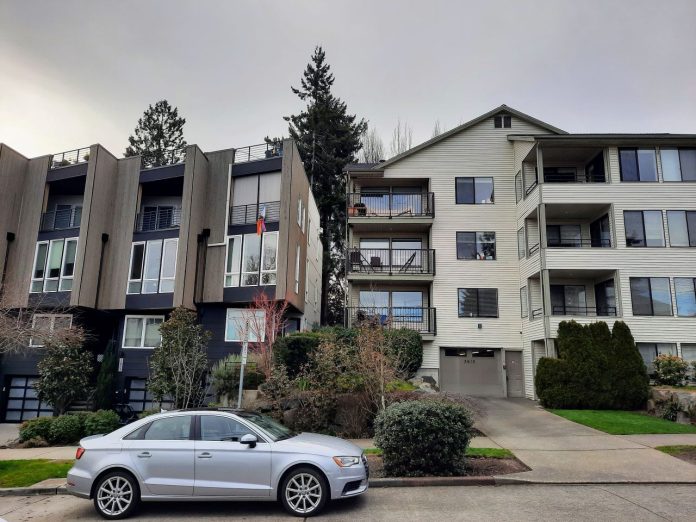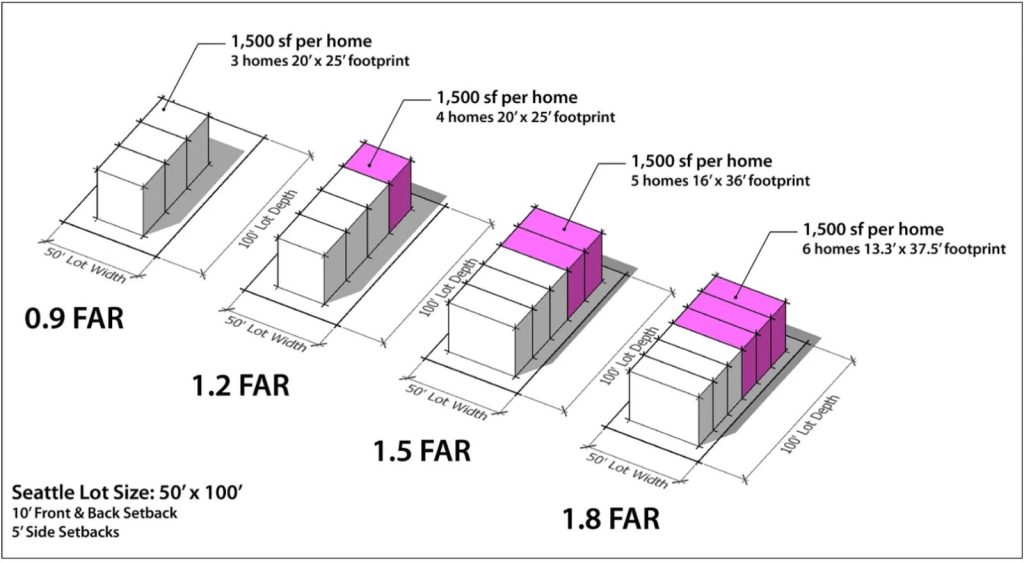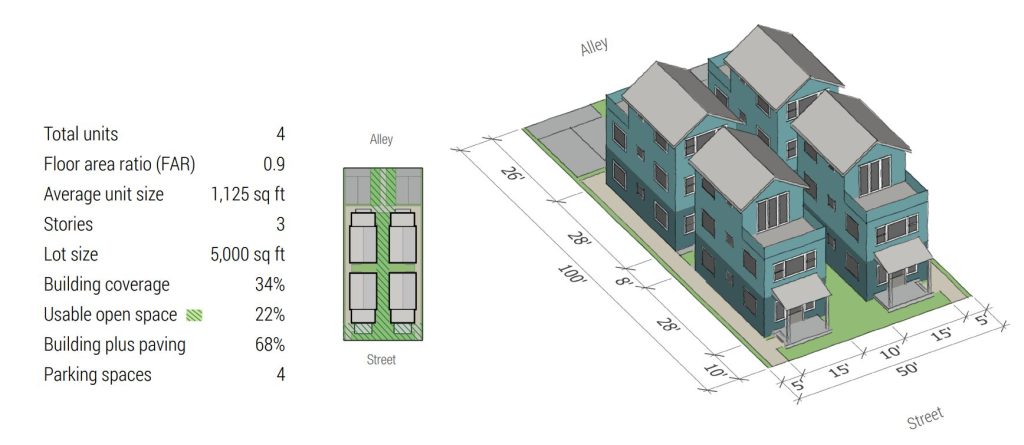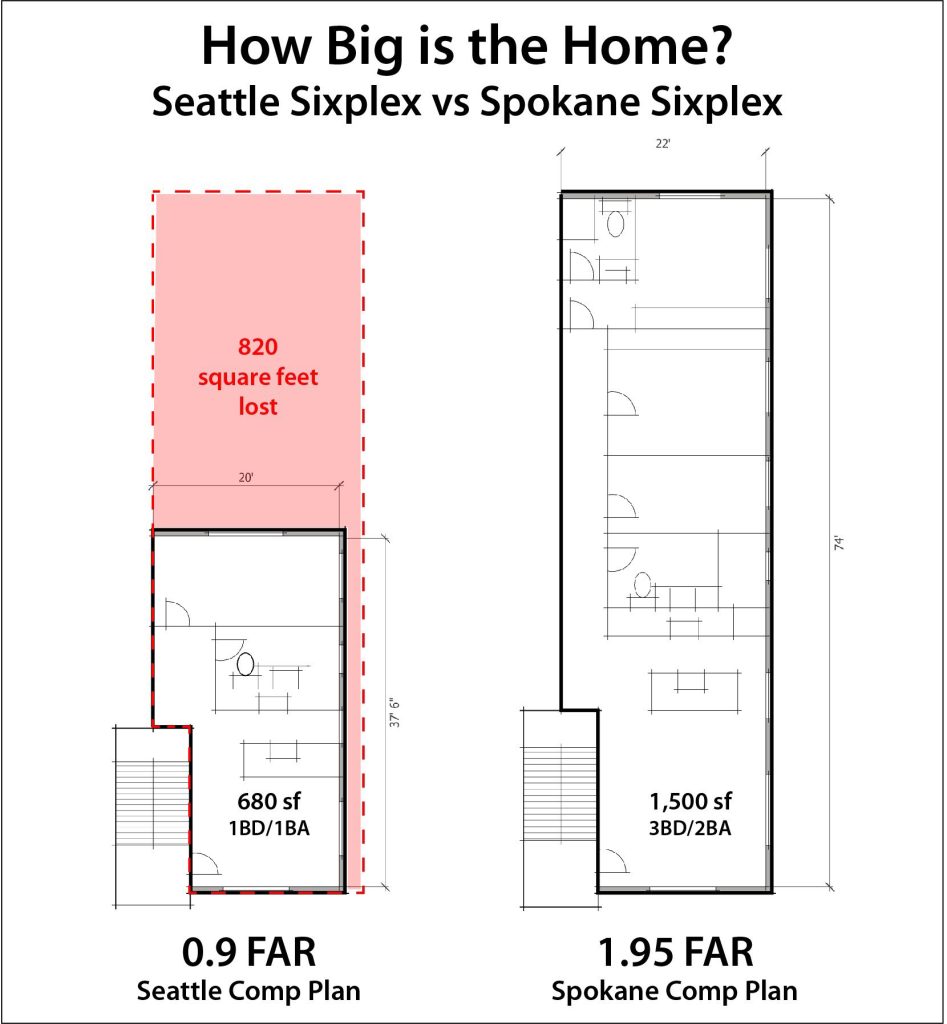
Seattle is in the midst of a zoning battle, and in typical Seattle fashion, one option on the table pretends to do a lot while accomplishing very little, actually defending the status quo. Namely, the City has proposed to allow fourplexes in single-family zones and sixplexes near major transit stops, as the new minimum standard mandated by the state. However, the accompanying development regulations will not actually permit much larger buildings than are currently allowed, which would force each home to get smaller and skinnier or not happen at all, with the latter appearing more likely.
Whether these regulations actually comply with the state mandate for “missing middle” housing — now in force for the first time under House Bill 1110 — is up for some debate. The bill’s primary architect, Olympia Rep. Jess Bateman, expressed serious doubts that it would comply, but that is another story.
Not encouraging housing growth in Seattle’s ubiquitous “Neighborhood Residential” (NR) zones, where single-family homes predominate, is a bad policy choice on its own merits, even before factoring in the fact that the city could fall out of compliance with state law and risk legal action.
And unlike the decision to shrink “Neighborhood Centers,” cut their proposed quantity in half, and mostly eliminate transit corridor rezones from the City’s draft proposal, the middle housing decision has not been tied to any intervention from cabinet officials in Mayor Bruce Harrell’s administration, as our reporting at The Urbanist first revealed. It could be the Office of Planning and Community Development (OPCD) opted for strict building size restrictions for NR zones all on their own — although if Harrell officials disagreed they could have overruled the planners, as they did in cutting Neighborhood Centers and transit corridor zones. But it’s not too late to get it right in the final plan.
A broad coalition of more than 50 organizations (including The Urbanist) sent a letter to the City of Seattle urging them to improve the plan. Crosscut‘s Josh Cohen noted the coalition includes “political heavy hitters” like the Seattle Metropolitan Chamber of Commerce, real estate groups, nonprofit builders, and advocacy groups — the MLK County Labor Council also voted to endorse the letter this week. First on the coalition’s list of demands: “Allow for More Family-Sized Homes in Middle Housing: Increase the Floor Area Ratio (FAR) for fourplexes and sixplexes, to make it possible to build more family-sized homes.”
By a wide margin, Seattle’s low-density residential areas are high-opportunity, low-displacement risk neighborhoods. Growth fits in these neighborhoods and increases access to high quality schools and parks, creating family-sized housing that could be priced within the range of working class families if we actually calibrate our regulations to encourage such housing rather than the opposite.

In turn, the added housing creates more opportunities for entrepreneurs to open small businesses, such as a neighborhood cafe, or a bodega, or a daycare, or for a grocery store or pharmacy to go in and hang on — a real problem as many neighborhoods face grocery store and pharmacy closures. This fosters more 15-minute neighborhoods, where residents can meet their basic needs within a 15-minute walk of home, improving quality of life for residents old and new.

But it’s not just heady planning concepts like 15-minute cities that behoove us to rethink the single-family status quo. Many reasons to embrace middle housing in single-family areas exist. Here are just a few:
- Seattleites want more housing options. Many people would prefer housing options other than skinny, undersized townhomes if offered them. The City’s own outreach on the plan and polls of Seattle voters show strong support that is steadily increasing for adding new housing options in neighborhoods across the city.
- A sixplex boom can bring down housing costs. It’s called missing middle, because the middle rungs in our ladder of housing options have nearly disappeared in most coastal American cities. Providing another step up puts downward price pressure on the housing options on the lower rungs. Plus, putting more homes on each parcel of land lowers the land cost for each resident, allowing more economical homes.
- Underbuilding with townhomes can be a forever mistake. Once townhomes are built, they lock in the land use patterns basically forever since the land gets subdivided into tiny parcels. This makes adding additional housing capacity much more difficult down the road.
- The state and other cities are setting a higher standard. Other Washington cities are allowing much bigger homes with their middle housing zoning. Spokane, for example, is allow buildings to be more than twice the size of Seattle’s zoning proposal. Redmond, too. The state’s model middle housing code would allow homes that are about 80% larger than Seattle.

- Seattle needs family-sized housing and NR zones are a great place for it. While City projections show that midrise and highrise housing will continue to shoulder most of the load for Seattle’s growth, middle housing can increase our family-sized options with three bedrooms or more.
- Housing growth in more neighborhoods furthers aging in place. More housing diversity in single-family neighborhoods means older folks can downsize more easily and younger folks can get a flat or townhome closer to where they grew up. Diversity of housing options helps families age in place.
- Diversifying beyond townhomes. More flexible regulations could allow for the real possibility of stacked flats or small apartment or condo buildings rather than pigeonholing developers into awkward-sized townhomes. With parking mandates (which the Harrell Administration are still flirting with keeping), townhomes become mostly garages and alleys rather than creating high quality streets with permeability and ample green space. The tree-canopy-friendly Seattle Sixplex could become a thing if the rules don’t get in the way.
- Displacement risk is very low. In areas where displacement risk is high, the Harrell Administration has proposed to cap development at triplexes rather than fourplexes and sixplexes, providing an added drag on redevelopment. It’s not clear if this strategy would constitute an effective anti-displacement and racial equity strategy, but it does mean that remaining places where fourplexes are proposed were determined to be low displacement risk.
Middle housing isn’t going to turn into the main driver of housing growth in Seattle — that will continue to fall on large multifamily projects — but that doesn’t mean Seattle should cordon off NR zones from growth and shirk its responsibilities under state housing reform. Those new mandates and standards were intended to encourage collaboration rather than a race to the bottom to obstruct housing and invent new hurdles. Seattle has to step up or invite even greater intervention from state lawmakers. A change as simple as following the state model code would allow far more middle housing to be built across this city.
The draft growth strategy in the Seattle Comprehensive Plan is open for comment through 5pm on Monday, May 20 via the online Engagement Hub or via email. Seattle will need to finalize the plan later this year, with the comp plan update due by year’s end (deadline the city very well may miss) and the state’s firmer missing middle deadline looming in July 2025.
Doug Trumm is publisher of The Urbanist. An Urbanist writer since 2015, he dreams of pedestrian streets, bus lanes, and a mass-timber building spree to end our housing crisis. He graduated from the Evans School of Public Policy and Governance at the University of Washington in 2019. He lives in Seattle's Fremont neighborhood and loves to explore the city by foot and by bike.

